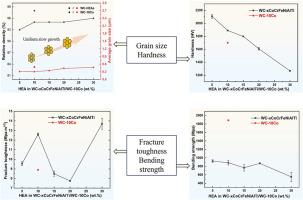Effect of AlCoCrFeNiTi high entropy bonding phase with different content on properties and microstructure of WC cemented carbide
IF 6.6
2区 材料科学
Q1 MATERIALS SCIENCE, MULTIDISCIPLINARY
Journal of Materials Research and Technology-Jmr&t
Pub Date : 2025-09-13
DOI:10.1016/j.jmrt.2025.09.074
引用次数: 0
Abstract
This study systematically investigated the effects of AlCoCrFeNiTi high-entropy alloys with different contents (5–30 wt%) as binder phases on the microstructure and mechanical properties of WC cemented carbides. The results showed that the high-entropy binder phase significantly inhibited the growth of WC grains through the high-entropy effect. Among them, WC-10AlCoCrFeNiTi exhibited the optimal comprehensive performance, with an average grain size of 0.308 μm, which was 36.9 % smaller than that of traditional WC-10Co (0.488 μm). Its hardness reached 1889.5HV (1700HV for WC-10Co), and the fracture toughness was 12.69 MPa m1/2 (8.9 MPa m1/2 for WC-10Co). However, the insufficient wettability of the high-entropy binder phase led to lower relative density and bending strength of WC-5AlCoCrFeNiTi–WC-30AlCoCrFeNiTi alloys compared with WC-10Co. When the content of the high-entropy binder phase increased to 30 wt%, the grains abnormally grew to 0.473 μm, but the relative density of the alloy increased to 96 %, and the fracture toughness anomalously increased to 13.7 MPa m1/2, which was attributed to the synergistic effect of the crack deflection effect of coarse grains and high density. The fracture morphology indicated that the increase in high-entropy content promoted the transformation of the fracture mechanism from brittle fracture to ductile fracture.

不同含量的AlCoCrFeNiTi高熵结合相对WC硬质合金性能和组织的影响
系统研究了不同含量(5 ~ 30 wt%)的AlCoCrFeNiTi高熵合金作为结合相对WC硬质合金组织和力学性能的影响。结果表明,高熵结合相通过高熵效应显著抑制WC晶粒的生长。其中WC-10AlCoCrFeNiTi综合性能最佳,平均晶粒尺寸为0.308 μm,比传统WC-10Co (0.488 μm)小36.9%。其硬度达到1889.5HV (WC-10Co为1700HV),断裂韧性为12.69 MPa m1/2 (WC-10Co为8.9 MPa m1/2)。但由于高熵结合剂相润湿性不足,导致WC-5AlCoCrFeNiTi-WC-30AlCoCrFeNiTi合金的相对密度和抗弯强度低于WC-10Co。当高熵结合剂相的含量增加到30 wt%时,合金的晶粒异常增大到0.473 μm,但合金的相对密度增加到96%,断裂韧性异常增大到13.7 MPa m1/2,这是由于粗晶和高密度的裂纹偏转效应协同作用所致。断口形貌表明,高熵含量的增加促进了断裂机制由脆性断裂向韧性断裂转变。
本文章由计算机程序翻译,如有差异,请以英文原文为准。
求助全文
约1分钟内获得全文
求助全文
来源期刊

Journal of Materials Research and Technology-Jmr&t
Materials Science-Metals and Alloys
CiteScore
8.80
自引率
9.40%
发文量
1877
审稿时长
35 days
期刊介绍:
The Journal of Materials Research and Technology is a publication of ABM - Brazilian Metallurgical, Materials and Mining Association - and publishes four issues per year also with a free version online (www.jmrt.com.br). The journal provides an international medium for the publication of theoretical and experimental studies related to Metallurgy, Materials and Minerals research and technology. Appropriate submissions to the Journal of Materials Research and Technology should include scientific and/or engineering factors which affect processes and products in the Metallurgy, Materials and Mining areas.
 求助内容:
求助内容: 应助结果提醒方式:
应助结果提醒方式:


